The CHL Top Prospects Game is a one-off event, with the
testing portion perhaps more important than the game itself.
The standouts certainly help their stock for the upcoming
NHL draft, but a mediocre performance shouldn’t hurt too badly in the big
picture.
The full-time scouts for NHL teams will see all these
prospects several times over the course of the season — and have been watching
them for years already — so there aren’t too many conclusions drawn from this
showcase. Good or bad.
Still, it is a best-on-best competition among the top
draft-eligible talents from the Canadian Hockey League — the WHL, OHL and QMJHL
— and the spotlight shines brightly on them for this nationally televised game,
which is attended by most NHL general managers and their chief amateur scouts.
With that in mind, here is a look at who could be trending up and down coming out of this year’s CHL Top Prospects Game in Hamilton, Ont., where Team White defeated Team Red 5-3 on Jan. 16.
Trending Up
Tyson Foerster (RW, Canada, Barrie OHL)
Showing up on the scoresheet is a great way to get noticed.
Foerster scored twice and had a nice primary assist in a three-point
performance that probably propelled him into the second-round range. For the
scouts who were already that high on him, this showing solidified their stance
and could push him into their top 50.
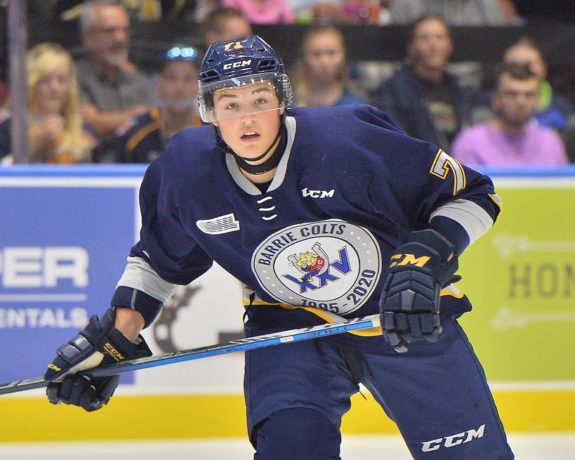
Foerster tied the game 2-2 with a wicked release on a
short-side wrister off a partial break, then gave Team White a 3-2 lead by firing
into a gaping net to finish a four-way passing play for the prettiest goal of
the game. He also set up the 4-2 goal by spotting Braden Schneider sneaking
into the slot from his point position.
Foerster reminds me a bit of Tanner Pearson, who played for
the same junior program in Barrie. Neither are great skaters — in terms of
acceleration and explosiveness — or flashy puckhandlers but both are scorers
with a shoot-first mentality and a nose for the net.
Lukas Cormier (LD, Canada, Charlottetown QMJHL)
Cormier was arguably the most active player in the Top
Prospects Game, noticeable on almost every shift and at both ends of the ice.
His offensive instincts were on full display, with no hesitation to join the
rush. He got caught up the ice on Foerster’s 2-2 goal but was mostly making a
positive difference in generating chances and tilting the ice in his team’s
favour.
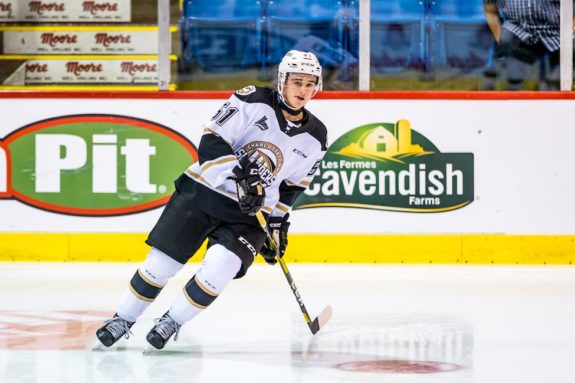
The good far outweighed the bad when it comes to Cormier’s
decision-making, displaying impressive vision and the ability to skate his way
out of trouble. He was elusive with the puck in the defensive zone, escaping
pressure with his smarts while alleviating size concerns. And he really shone
on the power play, with a commanding presence from the point.
Cormier could pass as a clone of Colorado’s Samuel Girard,
playing a very similar style with much the same poise. Cormier was held off the
scoresheet in this showcase but made a very strong case to be a first-round
pick.
Ryan O’Rourke (LD, Canada, Sault Ste. Marie OHL)
O’Rourke played a key role in Team White’s triumph despite
only getting credited with one assist. He deserved a second helper for leading
the rush and starting that four-way passing play on Foerster’s 3-2 goal.
O’Rourke was the catalyst there, dropping the puck for Ridly Greig’s subtle
touch before Connor Zary fed Foerster for the finish. O’Rourke also had a hand
in Foerster’s 2-2 goal, getting the secondary assist by quickly transitioning
the puck to Zary, who promptly sprung Foerster.
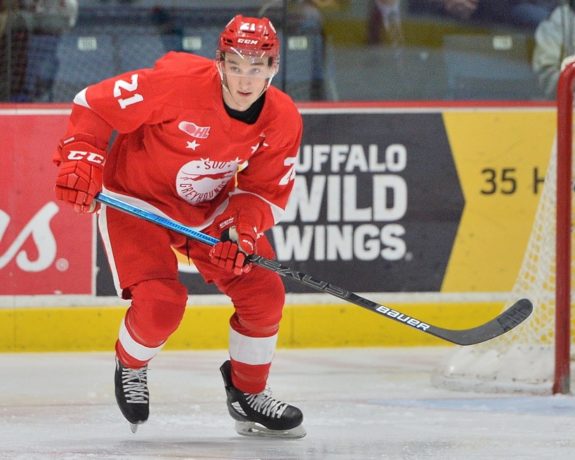
O’Rourke came as advertised with his puck-moving ability — from quick-ups to cross-ice feeds — and made the most of his touches throughout the game. Often times, the puck wasn’t on his stick for long but many of Team White’s scoring chances could be traced back to O’Rourke’s breakouts, including a Cole Perfetti opportunity early in the third period. O’Rourke reads the game at a high level with tremendous vision and that should translate well to the NHL, which could result in him becoming a first-rounder too.
Connor Zary (LC, Canada, Kamloops WHL)
Zary developed instant chemistry with his linemates — Foerster and Greig — and dished out three assists to continue his rise towards the top 10. As mentioned, Zary headmanned the puck for Foerster’s 2-2 goal and made a marvelous feed across the slot for Foerster’s 3-2 goal. Those primary helpers highlighted Zary’s passing skills and his secondary assist on the 4-2 goal didn’t go unnoticed, making a smart and unselfish play at the side of the net in deferring to Foerster in a better shooting position that he also passed up in finding Schneider.
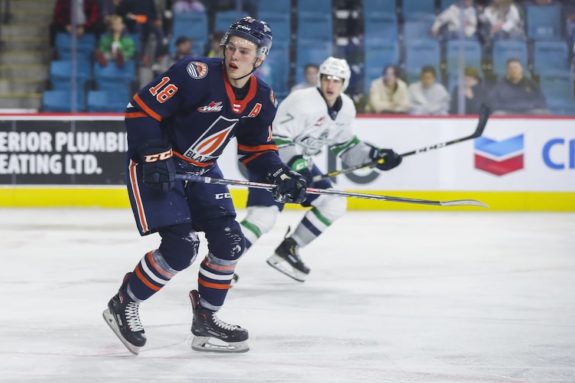
Zary seemed to be driving that line and had a couple scoring
chances of his own stopped in the first period. As the game progressed, Zary
also did his part to preserve Team White’s lead, blocking a Kasper Puutio shot
on a penalty kill in the third period. Zary’s defensive game is underrated —
his awareness and anticipation are unheralded strengths — but he’ll regret
being slow to react on Dawson Mercer’s last-second goal that spoiled the
shutout for his Kamloops teammate Dylan Garand. Besides that little lapse, Zary
was one of the stars on this night.
Jacob Perreault (RW/RC, Canada/USA, Sarnia OHL)
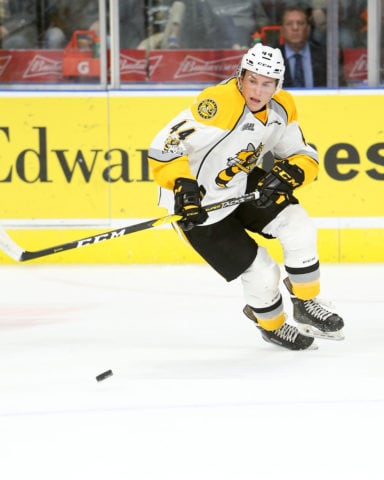
Perreault made his mark in the testing, topping the forward skating drills — both with and without the puck — and also placing top three in weave and transition agility. That was something of a surprise, to see Perreault beat out speedster Jean-Luc Foudy, among others — especially since skating was once perceived as a knock on Perreault that had been keeping him out of the first round in some rankings. He has evidently made significant strides in turning that into a strength. A knock no more.
Perreault also had his moments in the game, delivering a perfect slap-pass to Jack Quinn for a tap-in on Team Red’s 2-1 goal. That all-OHL line — also featuring Marco Rossi — was buzzing at times, though Perreault didn’t generate a ton of offence.
Worth noting, Perreault was wearing a full face shield in recovering from a broken nose, which may have hindered his impact to some extent. Still, Perreault is looking more and more like his Sarnia teammate Jamieson Rees, a second-rounder in 2019. That is meant as a compliment, for the record.
Kaiden Guhle (LD, Canada, Prince Albert WHL)
Guhle’s goal six minutes into the first period got him going and he was fully engaged for the entire game. A case could be made for Guhle as Team White’s most impactful defender — even ahead of O’Rourke. Guhle was a physical presence, forming an effective pairing with fellow WHLer Braden Schneider. Guhle really controlled the play on his side of the ice, shutting down the opposition with aggressive and assertive defending. The scouts definitely took notice.
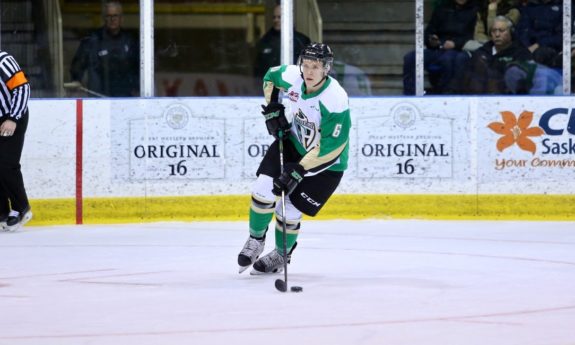
Braden Schneider (RD, Canada, Brandon WHL)
Schneider scored what stood up as the winner, displaying
great recognition on his goal to pinch down into the open space and making no
mistake on the shot from Foerster’s feed. Schneider complemented Guhle throughout,
working well together in bolstering each other’s stock. It will be interesting
to see which of those Dub defenders will hear their name called first in
Montreal this June. Both could be called in the first round — in the top 31
— following this strong showing.
Jeremie Poirier (LD, Canada, Saint John QMJHL)
Poirier opened the scoring for Team Red, getting the 1-0
goal on a quick shot from a good feed by Luke Evangelista. Poirier played to
his strengths, getting involved offensively and leading multiple rushes. He
nearly connected with Evangelista on another goal in the second period thanks
to Poirier’s zone entry. There was plenty to like about Poirier’s game — nearly
as much as fellow QMJHLer Cormier — and he certainly looked like a first-round
talent.
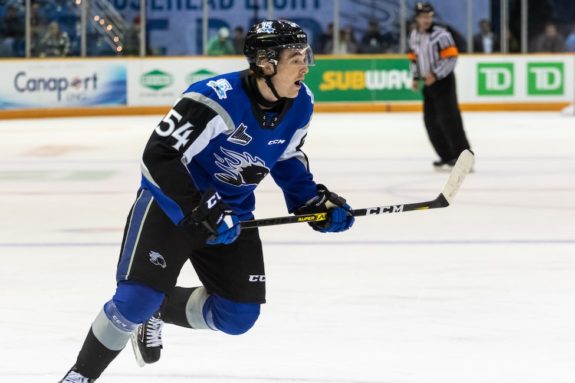
Marco Rossi (LC, Austria/Switzerland, Ottawa OHL)
Rossi was a real catalyst, making things happen with the puck on his stick. He is shifty and capable of spinning to create time and space, reminiscent of Pavel Datsyuk — the former NHL star that he emulates as his favourite player. Like Datsyuk, Rossi is strong on the puck for a smaller forward, protecting possession while processing his next move. He was limited to one assist but easily could have produced a three-point performance. It was evident to the eye exactly why and how he is lighting up the OHL.
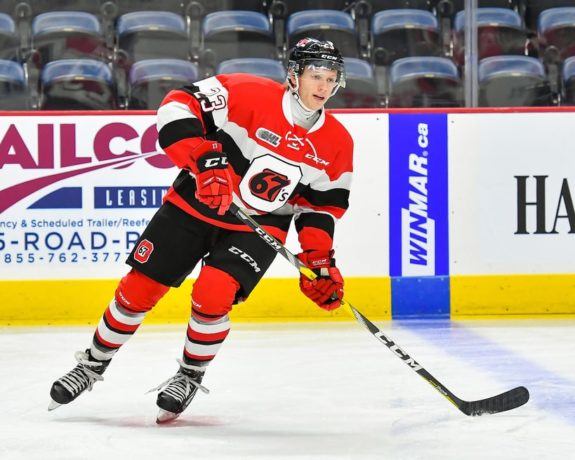
Cole Perfetti (LW/LC, Canada, Saginaw OHL)
Perfetti had a similar impact to Rossi, possessing the puck as much as anybody. Perfetti has become more of a playmaker, looking like a different player from the sniper we saw at the Hlinka. His only recorded shot went into the empty net to seal Team White’s win — well, it took two shots to get that goal, with the first hitting the post. Perfetti had a dominant shift earlier in the third period, which included a set-up for Vasily Ponomarev, and his primary assist on Guhle’s 1-1 goal also made the highlight reel. You’d like to see him shoot more often — as arguably the best shooter in this draft class — but Perfetti found other ways to impress. He even helped contain Quinton Byfield on the defensive end, but his dazzling dangles and individual efforts in the offensive zone stood out above all else.
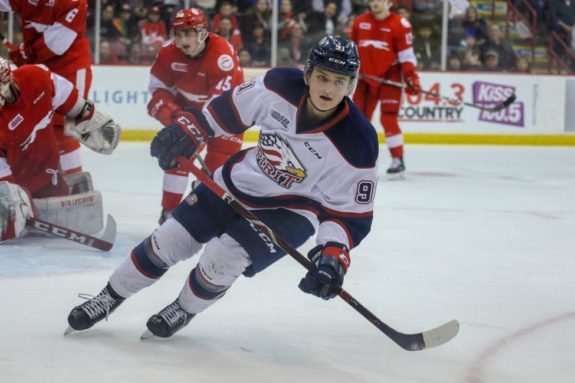
Jack Quinn (RW, Canada, Ottawa OHL)
Quinn’s goal was a gift — tapping in a three-way passing
play with Perreault and Rossi — but he played a real complete game with his
share of good moments. Quinn has been a big riser in recent months — thanks to
netting 35 goals (and counting) in the OHL — and you can just tell he is going
to be a player. He’ll be able to play a variety of roles as a pro, so it’s no
surprise that he is trending towards being a first-rounder and perhaps a top-20
pick.
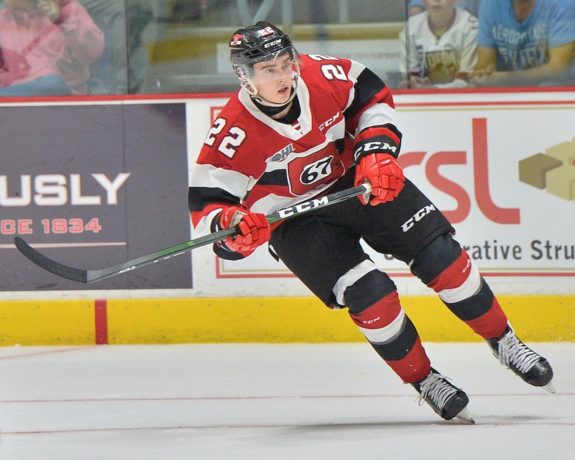
Dawson Mercer (RW, Canada, Chicoutimi QMJHL)
Mercer is much the same as Quinn, another complete player
that is sure to be a quality pro. Mercer is also a scorer and a finisher around
the net, showing off his good hands with a tuck job from the top of the crease
for the game’s final goal. That buzzer-beater got him on the scoresheet, which
is always beneficial, but Mercer was already the most noticeable player on his
line with Quinton Byfield and Jake Neighbours. It wouldn’t be shocking if Mercer
was taken in the top 20.
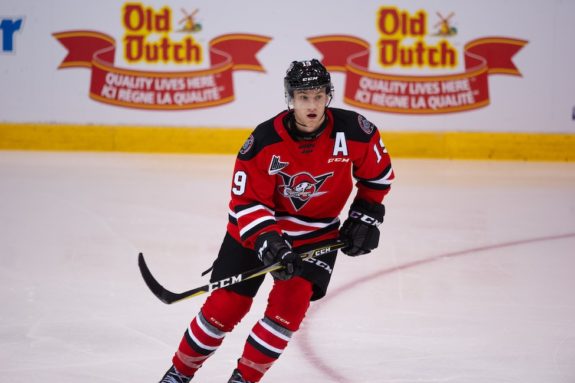
Luke Evangelista (RW, Canada, London OHL)
Evangelista set up Poirier for the game’s opening goal in
impressive fashion and generated a few other chances. It was a consistent
effort from Evangelista, who made things happen off the rush and should be
rising into the 50-75 range — certainly somewhere in the top 100. Those who
watch London on a regular basis are becoming big fans of Evangelista, believing
he could overtake his more highly touted teammate — this next guy — between now
and June, perhaps pushing for the first round.
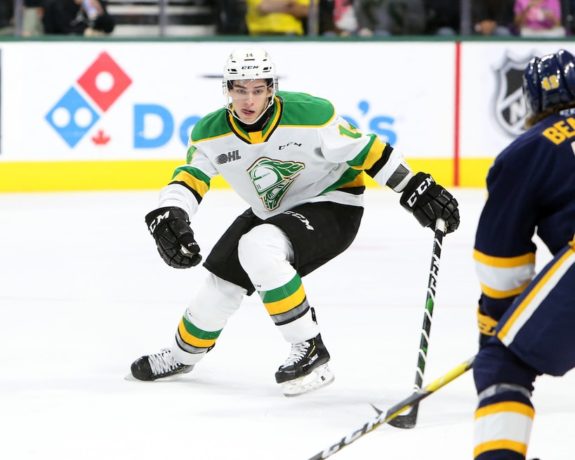
Antonio Stranges (LC/LW, USA, London OHL)
Stranges needed a strong showing to stay in the top 50 — to
stay in the first-round conversation — and he managed to deliver on this stage.
Stranges displayed some of his dynamic skill — including that 10-and-2 skating
technique — and appeared confident in his own abilities. He was a bit trigger
happy, selfishly opting to shoot at times, but the offensive upside was apparent.
The positives outweighed the negatives for Stranges, but he was guilty of
committing a careless turnover that led to Perfetti’s empty-netter, which
further raised concerns over his individualistic play, decision making and
hockey sense. Whoever drafts Stranges will need to take the good with the bad,
but he did put his best foot forward here.
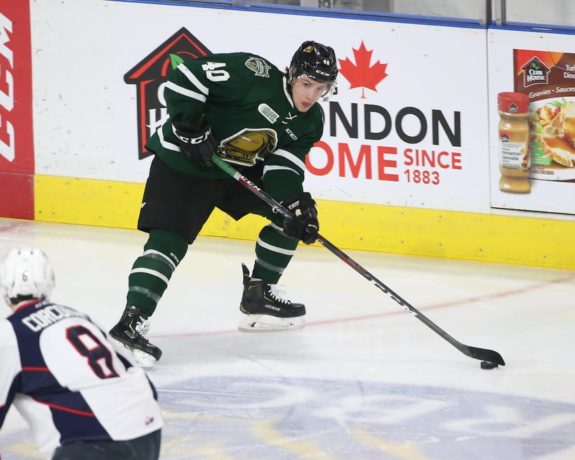
Ridly Greig (LC/LW, Canada, Brandon WHL)
Greig was overshadowed by his linemates — Zary and Foerster — but made a positive impression in his own right. Greig was only credited with one assist despite scoring a goal that was overturned — due to goaltender interference by Jaromir Pytlik — and coming close on a breakaway that Gould blockered away. Greig’s speed and physicality created time and space for his line from the outset, throwing one of the game’s biggest hits in the early stages on Donovan Sebrango. Greig has been coming on strong for Brandon, looking more like a second-rounder lately.
Kasper Puutio (RD, Finland, Everett WHL)
Puutio entered under the radar and presumably exceeded expectations. Things are looking up for Puutio as of late, getting traded from a poor Swift Current team to a contender in Everett, then making the most of this opportunity. He was a pleasant surprise, much more noticeable than anticipated and involved at both ends of the ice. His battle level was impressive, trying to be physical and defending aggressively, then flashing his offensive upside while quarterbacking a power play in the third period. Puutio made a lot of plays in making his case for the top 100.
Thimo Nickl (RD, Austria, Drummondville QMJHL)
Nickl was another revelation, playing loose and confident in seemingly relishing this stage. At times, it looked like he was playing in an all-star game — or in all-star mode, by taking chances and getting up in the rush — but Nickl was quite noticeable and mostly for good reasons. His skating and offensive tools appeared promising, nearly connecting with fellow Austrian Marco Rossi for a highlight-reel goal. Overall, Nickl should have turned enough heads to be taken in the middle rounds.
Dylan Garand (G, Canada, Kamloops WHL)
Garand came within one second of pitching a shutout over the second half for Team White, stopping 10 of the 11 shots he faced. Garand was sharp when tested, stoning Rossi from the slot on a feed from Quinn for his best save. Garand has been in the zone ever since the calendar flipped to 2020 and he was coming off a rare highlight in winning a goalie fight just prior to the Top Prospects Game. January has been all kinds of good for Garand, but it’s tough to say where he’ll go in June since he is undersized by today’s NHL goaltending standards. Garand may be on the smaller side (listed at six foot even), but he outshone two bigger goalies in this showcase and has been stellar for Kamloops, so he deserves to get drafted in 2020.
Jean-Luc Foudy (RC, Canada, Windsor OHL)
Foudy was a testing standout, to no surprise. Fast on the
ice and strong off the ice, he is looking to follow in the footsteps of older
brother Liam, who was a first-round pick (18th overall) in 2018. Jean-Luc has a
ton of potential as a pro — thanks to that combination of speed and strength —
but he is underachieving to some degree during his draft year. He was a mixed
bag at the Hlinka and again in the Top Prospects Game, leaving a bit to be
desired from an individual standpoint and struggling to develop chemistry with
his WHL linemates Justin Sourdif and Ozzy Wiesblatt. Foudy will need to surge
down the stretch with Windsor to be taken in the first round.
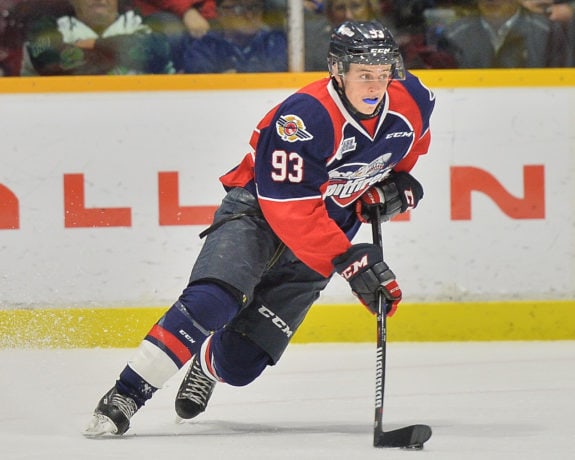
Jack Finley (RC, Canada, Spokane WHL)
Finley had a relatively quiet game — not necessarily a bad thing for a shutdown forward — but led all performers in the off-ice portion of the testing. He tied for first place in Medicine Ball Toss, took top spot in Right Grip, and was second in Pro-Agility Right. Finley finished top five in four events and didn’t place lower than 10th in any of the seven events. That was a strong showing and especially significant since Finley is one of the youngest prospects in the 2020 draft class with a September 2002 birthdate. He looks lanky — still growing into his 6-foot-6 frame — but obviously isn’t scrawny at 213 pounds. He has NHL bloodlines as the son of former blueliner Jeff Finley (presently an amateur scout for Winnipeg) and could be selected higher than he is ranked as a coveted right-handed centre with that kind of size and strength. Think Adam Lowry, but more of a playmaker.
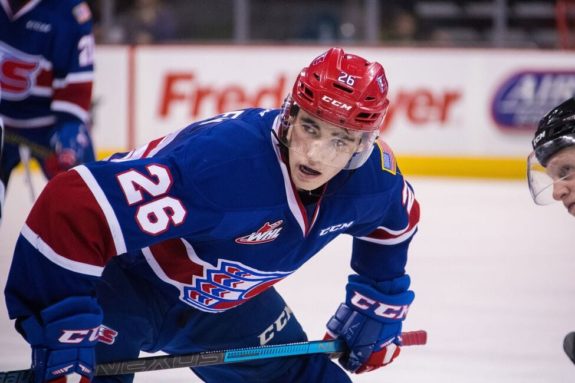
Trending Down
Quinton Byfield (LC, Canada, Sudbury OHL)
Byfield disappointed again, posting a blank stat-line in
another lacklustre showing on a best-on-best stage. Remember, he was mediocre
at the Hlinka last summer — tailing off as that tournament ramped up — and
worked his way down Canada’s depth chart at the recent World Juniors. By and
large, he has been invisible in the biggest games and unable to rise to the
occasion. That is an alarming trend, a red flag of sorts.
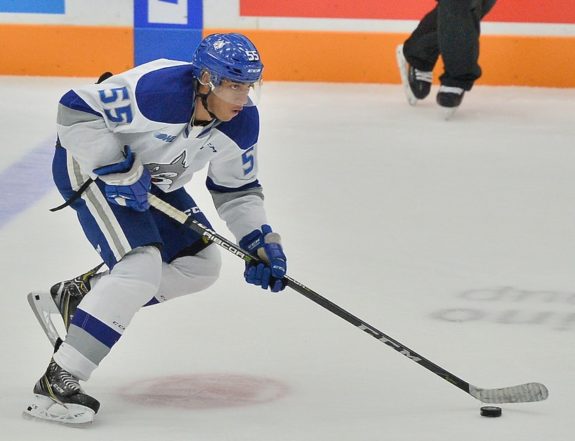
Byfield has been dominant in the OHL — in a familiar setting
with Sudbury — and he has sky-high potential but, reality is, his peers have
outperformed him at these marquee events. He failed to register a single shot as
Team Red’s captain, looking nothing like the second coming of Evgeni Malkin.
Granted, Malkin was enigmatic in his younger years before evolving into a
consistent force. Byfield has comparable tools and upside but is no longer a
lock to go No. 2 in 2020.
Justin Sourdif (RW, Canada, Vancouver WHL)
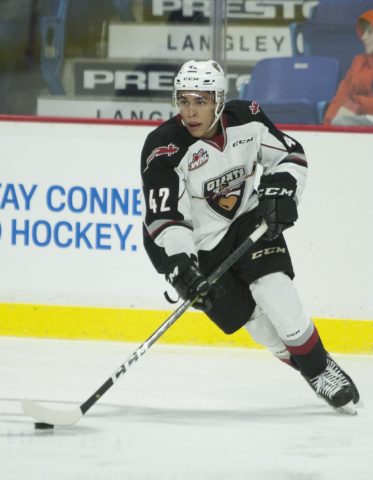
Sourdif has been slipping in the rankings and did little to
re-establish himself as a possible first-rounder. He had a quiet game with a
glaring minus-three rating, though he did set up that last-second goal with a
centering pass for Mercer to reach the scoresheet. Sourdif fended off Braden
Schneider behind the net to record that assist — finishing on a high note — but
didn’t do anything else of note.
Sourdif hasn’t been playing with as much jump lately —
leading to speculation that he could be playing through injury — but he’ll need
to get that edge back in his game if he hopes to be a riser down the stretch.
When Sourdif is going strong, he can be a hybrid between Evander Kane and
Brendan Gallagher — both alums of WHL Vancouver — but that energy and
physicality has been missing to start 2020, with his production also suffering
as a result. He is a second-rounder, barring a surge.
Brock Gould (G, USA, Moose Jaw WHL)
Gould had a golden opportunity — getting the full game in
goal for Team Red — but came out on the losing end after being exposed on the
blocker side a couple times. Those two goals — Kaiden Guhle’s 1-1 tally and
Foerster’s 2-2 marker — will go down as softies by NHL standards. Both were
short-side shots that shouldn’t have beat him, though he was partially screened
on Guhle’s goal.
Gould did settle in and didn’t have much chance on the 3-2 or 4-2 goals — 5-2 was an empty-netter — but he’d like to have those first two back. Technically, he was beaten six times, with two goals getting overturned — due to offside and goaltender interference. Gould made some decent saves along the way, stopping Ryan Francis and Ridly Greig in all alone, but the scouts won’t be too high on his overall performance despite placing first among the four goaltenders in their on-ice testing. Competing in six categories, Gould ranked first in Long Recovery Right, Short Recovery Right, and Goalie Pro Agility, second in Long Recovery Left and Y Pad Slide Total, and third in Short Recovery Left for whatever that is worth on the goalie front.
In Gould’s defence, it has been a whirlwind month for him —
getting traded from Victoria to Moose Jaw the previous week — so perhaps he’ll
rebound once he gets comfortable again. He’ll face plenty of rubber the rest of
the way on a weaker team, so scouts can see how he responds and determine his
draft value in the months to come.
Vasily Ponomarev (LC, Russia, Shawinigan QMJHL)
Ponomarev impressed in his previous best-on-best events —
with a stellar showing at the World Junior A Challenge following a productive
Hlinka tourney for Russia — but he struggled to hit his stride or find any
rhythm with his linemates in the Top Prospects Game.
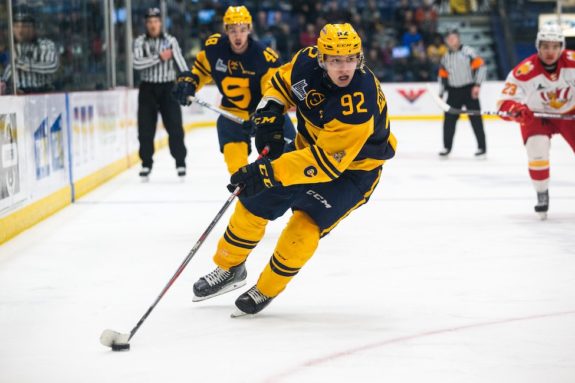
Ponomarev was centering Ryan Francis and Will Cuylle down
the depth chart for Team White and they didn’t generate much in the way of
offensive chances. They didn’t have a ton of possession time, partially because
Ponomarev went 1-for-10 in the faceoff circle. Ponomarev’s best chance was set
up by Cole Perfetti, getting off a quick release from a prime scoring spot in
the high slot that sailed wide.
Ponomarev is a first-rounder in many rankings — producing at
a point-per-game pace in his North American debut — but some scouts will still
be questioning his offensive upside and his role as a pro coming out of this
particular event.
Jaromir Pytlik (RC, Czech Republic, Sault Ste. Marie OHL)
Pytlik is another import that didn’t distinguish himself from the pack in this showcase, decreasing his chances of being a first-rounder. Pytlik played a safe game, making smart and simple plays for the most part. He forechecked hard, which is one of his stronger traits, but didn’t get involved in the offence.
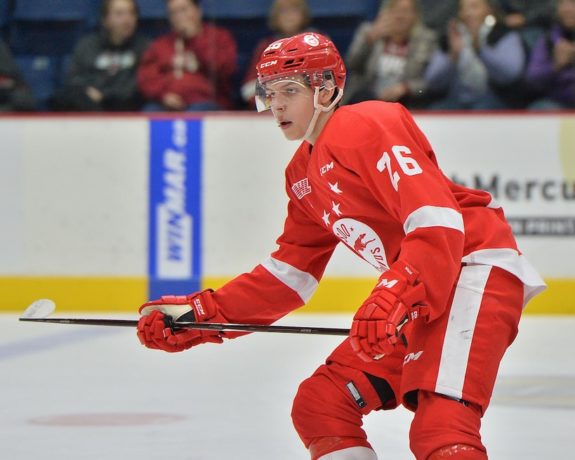
Pytlik’s line had potential for more, at least on paper —
centering fellow OHLers Cole Pefetti and Brandon Coe — but they didn’t click or
contribute to the win, aside from Perfetti’s unassisted empty-netter to round
out the scoring for Team White.
Will Cuylle (LW, Canada, Windsor OHL)
Cuylle played to his strengths as a physical presence — winning his fight with Donovan Sebrango and delivering a couple hard hits — but looked slow otherwise and didn’t show up offensively. Cuylle’s fighting style resembled Milan Lucic, but the rest of his game looked more like Zack Stortini than Zack Kassian. Mitch Moroz is another name that comes to mind as a comparable, yet some may see a young Tom Wilson. Cuylle needs to get quicker — both moving and thinking — to develop into a power forward and he needs to get scoring in the second half to remain in the second-round range.
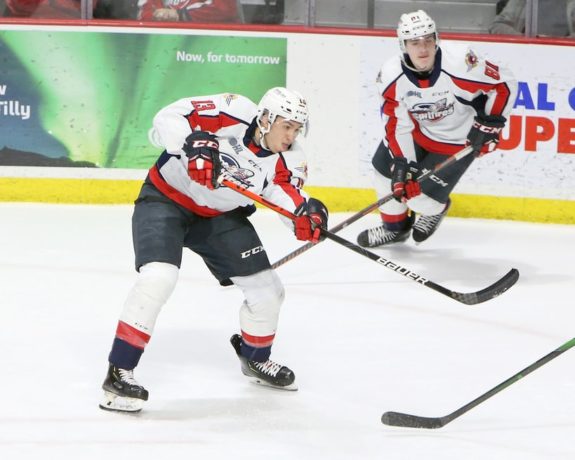
Jack Thompson (RD, Canada, Sudbury OHL)
Thompson struggled with the step up in pace from the OHL. He
was slow to react at times, seeming a half-step behind physically and mentally.
At other times, he tried to do too much. That led to overhandling the puck,
resulting in turnovers and unnecessary chaos. Thompson did register three shots
on goal despite looking a little out of his league. This learning experience
will ultimately benefit him in adjusting to the next level, with Thompson
projected as a middle-round pick.
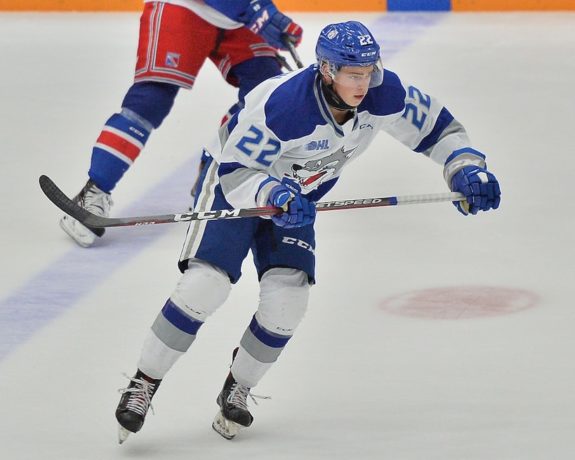
Donovan Sebrango (LD, Canada, Kitchener OHL)
Sebrango lost his fight with Cuylle and looked overmatched
in general. To his credit, Sebrango was trying to make an impression by playing
physical and getting involved in all facets of the game — moving and skating
the puck decently — but he appeared to be a step below his peers in getting
outshone by most the other defenders. Sebrango does everything fairly well but
nothing special, which means he’ll need to work his way to the big league. He
is already known for his work ethic and for being a gamer, so don’t count out Sebrango
in becoming a Marco Scandella type — even if he is drafted outside the top 100.
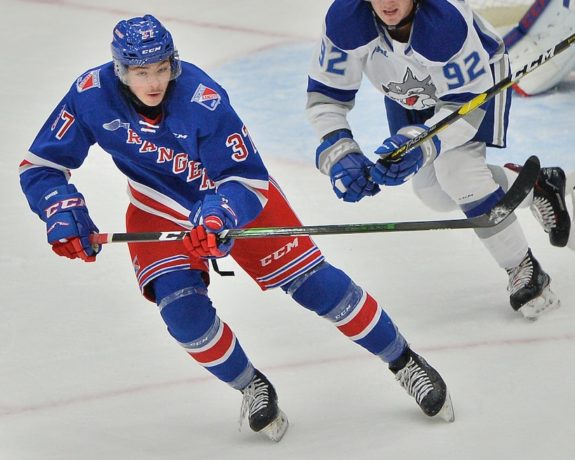
Nico Daws (G, Canada, Guelph OHL, overager)
Daws was hurt in the pre-game warmups — sustaining an
upper-body injury — and missed this showcase, which could have helped his stock
rebound from losing the starting role for Canada at the World Juniors. Daws
wasn’t great there — giving up four goals in each of his two appearances at the
prestigious tournament — but could have bounced back here like Mads Sogaard did
last year. Daws didn’t get that opportunity and time will tell whether he’ll
get drafted the second time around. Prior to the World Juniors, Daws was
regarded as one of the top overagers for 2020 — with the potential to go as
high as the second round — and the NHL scouts obviously wanted to see more of
him at the Top Prospects Game.
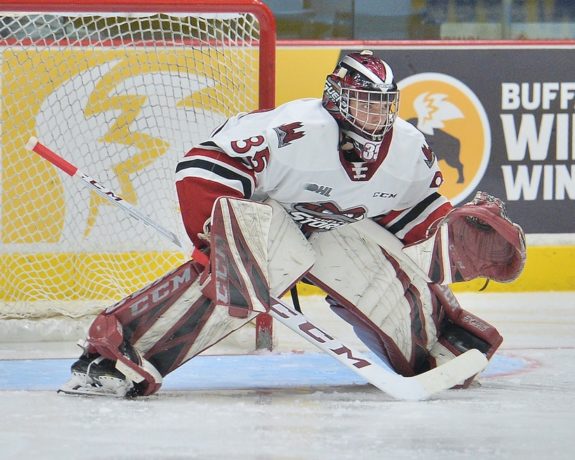
Status Quo
Alexis Lafreniere (LW, Canada, Rimouski QMJHL)
Lafreniere wasn’t pushing himself in this performance — he already made his emphatic statement as the MVP of the World Juniors — but still managed to score a goal that got called back for offside. Lafreniere’s far-side snipe past Gould would have given Team White a 2-1 lead.
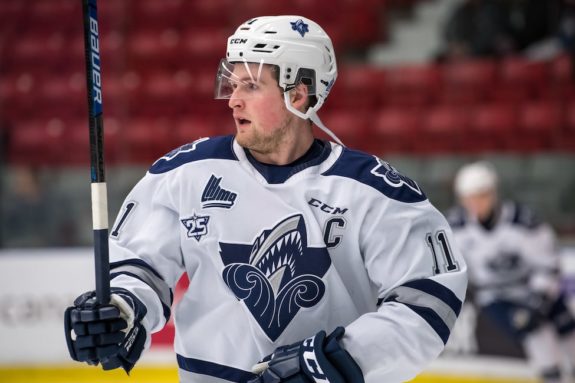
That was his only highlight on this night — mostly going through the motions, content to share the spotlight with others — though Lafreniere was still more impressive and noticeable than his nearest rival in this game, Byfield. Lafreniere lacked the intensity from the World Juniors but did lay one hit on the forecheck in showing off his complete game that includes physicality. Lafreniere has pulled away from Byfield and the rest of the pack in the top 10 to remain the consensus top prospect for 2020.
Jamie Drysdale (RD, Canada, Erie OHL)
Drysdale was subdued offensively but defended extremely
well, especially against the rush. He foiled Perfetti with a superb play just
prior to Guhle’s 1-1 goal and won several 1-on-1 battles all over the ice.
Drysdale clearly wanted to show off that side of his game as well as his
competitiveness, with everyone already aware of his offensive capabilities.
Mission accomplished in a solid if unspectacular outing.
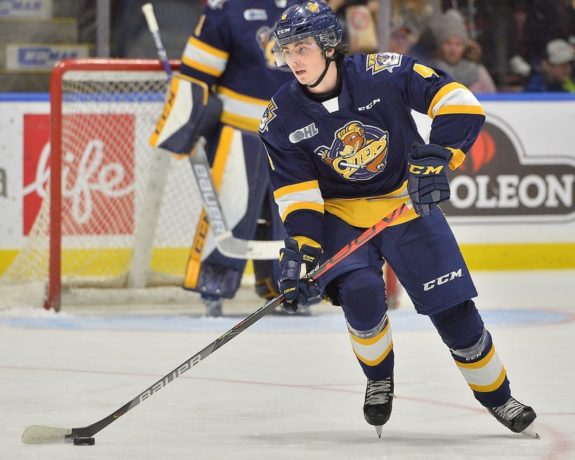
Mavrik Bourque (RC, Canada, Shawinigan QMJHL)
Mavrik Bourque was noticeable early — buzzing for his first
few shifts — but faded as the game progressed. The good moments still stood out
overall and he didn’t do anything to hinder his stock, so it’ll go down as a
beneficial showing. Bourque has been playing his way into the first round.
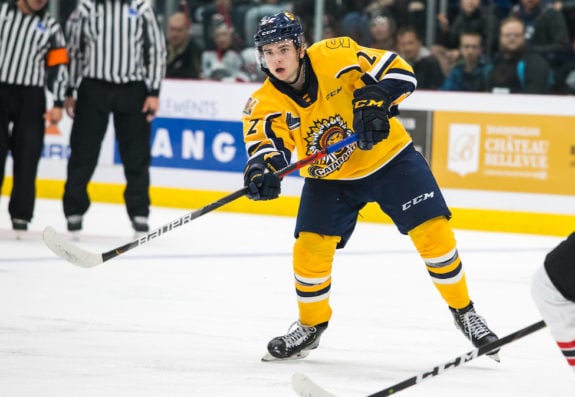
Seth Jarvis (RW, Canada, Portland WHL)
Jarvis had a couple chances that he couldn’t convert, but his
offensive instincts were evident. He was often in the right place at the right
time and could have had a few points. He clearly thinks the offensive side of
the game at a high level, with a high hockey IQ in general. That should
translate to success as a pro, which could thrust Jarvis into the first round.
Jake Neighbours (LW, Canada, Edmonton WHL)
Neighbours played his game, which is a well-rounded game. He
didn’t get much going offensively with Byfield and Mercer but had a 200-foot
impact with backchecking that got him noticed while being a physical presence
from start to finish. That line would likely click with a little more time
together — certainly over a seven-game series — but expect more of the same
from Neighbours, who can take his share of positives from this performance.
Like Jarvis, Neighbours is knocking on the door of the first round.
Brandon Coe (RW, Canada, North Bay OHL)
Coe also played within his means and didn’t do anything
special but sure looked like an intriguing talent. He has nice hands and moves
well for a big body, making subtle skill plays that suggest a fairly high
ceiling. If he gets a bit meaner — and plays a bit bigger — Coe could turn into
a real force as a pro. That upside could make him a top-100 pick.
Christoffer Sedoff (LD, Finland, Red Deer WHL)
Sedoff was solid defensively, keeping things simple for the
most part and relying on his strong skating to be effective. He had a handful
of good moments, resembling Olli Maatta in terms of his smarts and instincts.
The offensive upside may be limited with Sedoff — in comparison to fellow Finn Puutio
— but his shutdown abilities should get him drafted. If NHL teams see a Maatta type
in the making, Sedoff could crack the top 100 too.
Luke Prokop (RD, Canada, Calgary WHL)
Prokop had a hit-and-miss showing, which is typical of watching him in the WHL as well. He tried to do too much at times, overhandling the puck in the defensive zone and making some poor reads on breakouts, but he was active offensively and channelled his inner Travis Sanheim in taking the puck to the net on a couple occasions. Prokop isn’t as smooth as Sanheim — who was a first-round pick from the same junior team — but has a powerful stride and might possess similar upside with proper development over the next few years. Prokop is a bit clunky in the present but with plenty of room for refinement to reach the NHL. He will likely be a middle-round project.
Ozzy Wiesblatt (RC/RW, Canada, Prince Albert WHL)
Wiesblatt flashed his skill and attacking mentality in brief
glimpses but had his chances snuffed out and mostly played on the perimeter. He
got pushed off the puck a couple times and didn’t have an overly strong showing
for Team Red. Wiesblatt has similarities to former Prince Albert teammate Cole
Fonstad, who fell to the fifth round in 2018, but Wiesblatt should go in the
top three rounds in 2020 — probably in the top 75 and possibly in the top 50.
Ryan Francis (RW, Canada, Cape Breton QMJHL)
Francis also had his moments, setting up the disallowed goal
by Greig and getting denied by Gould on an attempted deke after getting behind
the defence, but his overall game was average at best. His line with Ponomarev
and Cuylle didn’t accomplish much for Team White, with Francis unable to spark
them. He was OK but didn’t do enough to emerge as a riser, projecting as more
of a middle-rounder right now — perhaps a third-rounder.
Samuel Hlavaj (G, Slovakia, Sherbrooke QMJHL, overager)
Hlavaj got the start for Team White and was solid in
stopping 11 of 13 shots, giving way to Garand shortly after their team went
ahead 3-2 midway through the second period. At 6-foot-4, Hlavaj is the same
height as Daws — and just one inch shorter than Gould — so he has the size that
NHL teams like to draft and develop.